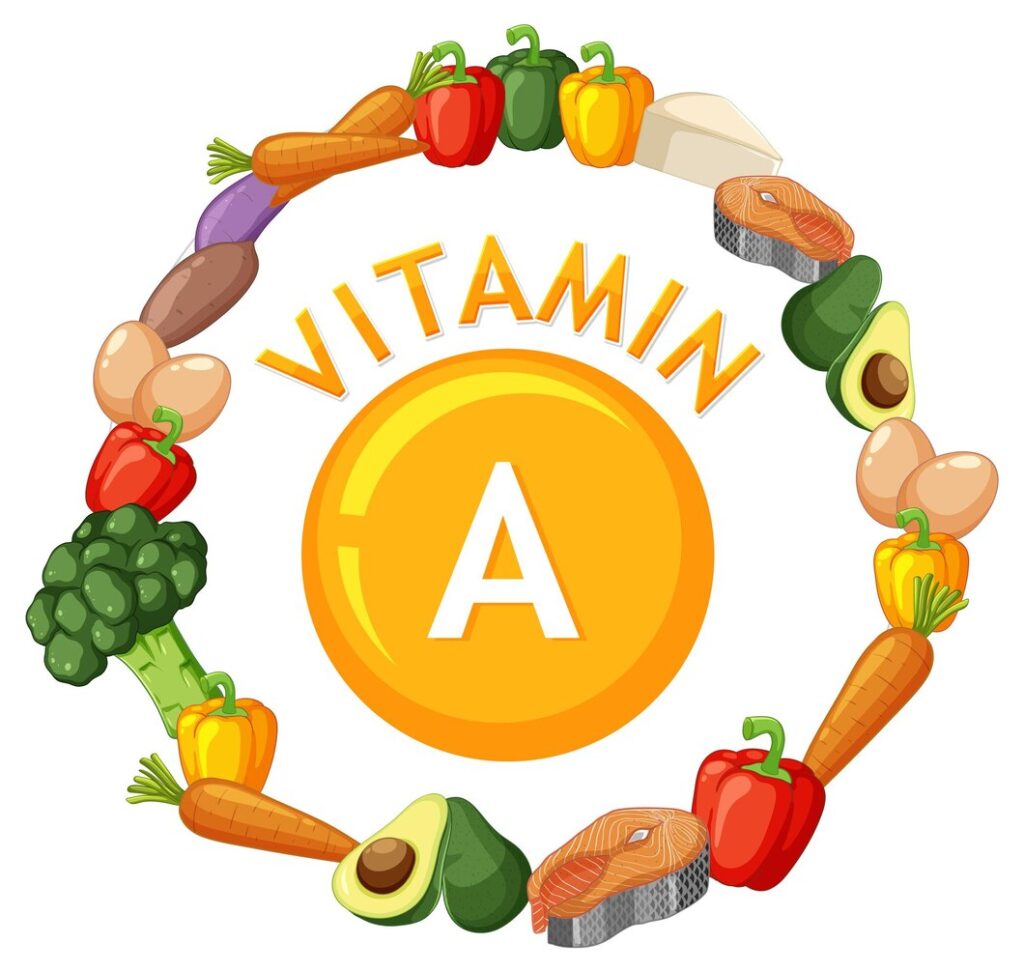Vitamin A;
What is Vitamin A?
Vitamin A, a fat-soluble nutrient, encompasses a group of compounds essential for numerous physiological functions in the human body. It exists in several forms, each with distinct roles and sources:
- Retinol: Found in animal-derived foods such as liver, eggs, and dairy products, retinol serves as the primary storage form of vitamin A in the body.
- Retinal: This form of vitamin A is crucial for vision, as it combines with opsin to form rhodopsin, a pigment essential for low-light vision.
- Retinoic Acid: A metabolite of retinol, retinoic acid is the biologically active form of vitamin A, regulating gene expression and cellular processes.
Functions of Vitamin A:
Vitamin A plays vital roles in various physiological functions, including:
- Vision Support: Retinal contributes to the formation of rhodopsin, facilitating vision in low-light conditions and maintaining visual acuity.
- Immune Function: Vitamin A enhances the function of immune cells, promoting immune responses and maintaining mucosal barriers to prevent infections.
- Cell Growth and Differentiation: Retinoic acid regulates cell growth, differentiation, and gene expression, essential for tissue development and repair.
Doses:
The recommended dietary intake of vitamin A varies based on age and life stage:
- Adults: Typically require around 900 micrograms (mcg) for men and 700 mcg for women per day.
- Children: Adequate intake ranges from 300 to 600 mcg, depending on age.
Deficiency of Vitamin A: Signs and Symptoms
Deficiency of Vitamin A
Vitamin A deficiency occurs when there is an inadequate intake or absorption of vitamin A-rich foods, leading to a range of health problems. Understanding the signs and symptoms of vitamin A deficiency is crucial for early detection and intervention. Here’s an overview with subheadings detailing the various aspects of vitamin A deficiency:
1. Causes of Deficiency:
- Inadequate Dietary Intake: Poor diet lacking in vitamin A-rich foods is a primary cause of deficiency, especially in regions with limited access to diverse food sources.
- Malabsorption: Certain medical conditions affecting the absorption of dietary fat can impair the absorption of fat-soluble vitamins like vitamin A. Examples include Crohn’s disease, cystic fibrosis, and bile duct obstruction.
2. Signs and Symptoms:
- Night Blindness: One of the earliest signs of vitamin A deficiency, night blindness, manifests as impaired vision in low-light conditions, making it difficult to see in dimly lit environments.
- Xerophthalmia: A severe form of vitamin A deficiency, xerophthalmia is characterized by dryness of the conjunctiva and cornea, leading to eye irritation, inflammation, and potentially irreversible damage.
- Follicular Hyperkeratosis: Phrynoderma, or follicular hyperkeratosis, presents as rough, bumpy skin resembling chicken skin due to inadequate vitamin A levels affecting skin cell growth and differentiation.
3. High-Risk Groups:
- Children: Young children, particularly in developing countries, are at high risk of vitamin A deficiency due to limited access to nutrient-rich foods and increased nutritional demands during growth and development.
- Pregnant and Lactating Women: Pregnant and lactating women have higher vitamin A requirements to support fetal development and breastfeeding. Inadequate intake during these stages can increase the risk of deficiency.
Foods Sources Rich in Vitamin A:

Vitamin A is abundant in various foods, both from animal and plant sources. Including these vitamin A-rich foods in your diet can help meet your daily requirements and support overall health. Here are some key food sources categorized into animal and plant sources:
Animal Sources:
- Liver: Liver, particularly from beef, chicken, and fish, is one of the richest sources of preformed vitamin A (retinol). Consuming liver provides a concentrated dose of vitamin A, making it an excellent choice for meeting daily requirements.
- Eggs: Egg yolks contain significant amounts of vitamin A, primarily in the form of retinol. Including eggs in your diet can contribute to your daily intake of this essential nutrient.
- Dairy Products: Milk, cheese, and yogurt are fortified with vitamin A in some countries. Check the labels to ensure you’re consuming products enriched with this nutrient.
- Fish Liver Oils: Cod liver oil and other fish liver oils are potent sources of vitamin A. They provide high concentrations of retinol and are commonly available in supplement form.
Plant Sources:
- Orange and Yellow Fruits: Fruits such as mangoes, apricots, papayas, and cantaloupes are rich in provitamin A carotenoids, such as beta-carotene. These compounds give these fruits their vibrant orange and yellow colors and serve as precursors to vitamin A in the body.
- Dark Green Leafy Vegetables: Vegetables like spinach, kale, collard greens, and Swiss chard are excellent sources of provitamin A carotenoids. Incorporating these nutrient-packed greens into your meals adds both flavor and nutritional value.
- Carrots: Carrots are renowned for their high beta-carotene content, making them a popular choice for boosting vitamin A intake. Enjoy raw carrots as a crunchy snack or add them to salads, soups, and stir-fries for added nutrition.
- Sweet Potatoes: Sweet potatoes are not only delicious but also packed with beta-carotene. Whether baked, mashed, or roasted, sweet potatoes make a nutritious and versatile addition to any meal.
- Pumpkin: Like other orange vegetables, pumpkin is rich in beta-carotene. Incorporate pumpkin into soups, stews, baked goods, and desserts to reap its nutritional benefits.
Including a variety of these vitamin A-rich foods in your diet ensures adequate intake of this essential nutrient, supporting vision, immune function, and overall health. Whether you prefer animal or plant sources, there are plenty of delicious options to choose from to meet your vitamin A needs.
Role in Conditions like Cancer
Vitamin A and its derivatives, known as retinoids, play significant roles in cancer prevention and treatment:
- Acute Promyelocytic Leukemia (APL): Retinoic acid is used as a therapeutic agent in the treatment of APL, promoting differentiation and inducing remission.
- Skin Cancers: Topical retinoids are effective in the treatment of certain skin cancers and precancerous lesions by promoting cell differentiation and apoptosis.
Summary: vitamin A is a vital nutrient with diverse functions crucial for maintaining vision, immune function, and overall health. Adequate intake through a balanced diet rich in vitamin A-containing foods is essential to prevent deficiency-related complications and support optimal health. Additionally, vitamin A and its derivatives hold promise in the prevention and treatment of various health conditions, including cancer.

Pingback: How to lose Weight When you have Heart Disease? - Modern Health
Pingback: Common Health Conditions - Modern Health